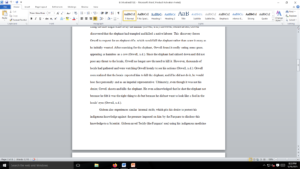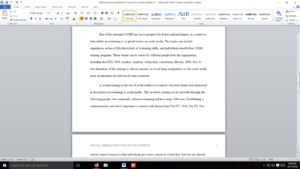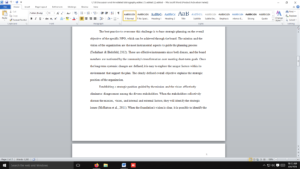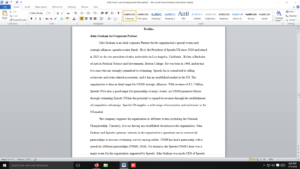For the Final Project, you will create a Resource Development Plan for a specific nonprofit organization. The nonprofit organization you select could be the one you developed for Introduction to the Nonprofit Sector. The organization for this is NAMI.
https://www.nami.org/Home
The assignment must be presented as a 15- to 18-page paper (not including references, title page, or abstract), double-spaced, following APA format guidelines. Your weekly assignments will assist you in developing the areas below.
At a minimum, the paper should include:
- Organizational mission
- Description of programs and services provided by the organization
- Brief history of the organization
- Current sources of funding
- Potential new sources of funding
- Cultivation strategies (for each source)
- Education strategies (for each source)
- Solicitation strategies (for each source)
- Appreciation strategies (for each source)
- Role of board and staff in identification, cultivation, education, solicitation and appreciation (#5–9 above) of funding sources
Use proper APA formatting and include the following in your paper:
- A title page and running head
- An introduction that states the purpose of the paper
- Level 1 headings to define each part of the paper
- A conclusion to synthesize the entire paper
- A minimum of 10 sources to support your paper
- In-text citations as appropriate
- A reference list
Your Final Project must demonstrate both breadth and depth of knowledge and critical thinking appropriate to graduate-level scholarship. It must follow APA Publication Manual 6th edition guidelines and be free of typographical, spelling, and grammatical errors. The project should be 15–18 pages (double-spaced), not including the title page, the abstract, and references.
References
Anna S. Artamonova. (2022). Financial resources management and assessment of the non-profit sector’s social efficiency. Journal of New Economy, 22(4), 97–115. https://doi.org/10.29141/2658-5081-2021-22-4-6
Drollinger, T. (2018). Using Active Empathetic Listening to Build Relationships With Major-Gift Donors. Journal of Nonprofit & Public Sector Marketing, 30(1), 37–51. https://doi.org/10.1080/10495142.2017.1326336
Ecer, S., Magro, M., & Sarpça, S. (2017). The Relationship Between Nonprofits’ Revenue Composition and Their Economic-Financial Efficiency. Nonprofit & Voluntary Sector Quarterly, 46(1), 141–155. https://doi.org/10.1177/0899764016649693
Finley, A. R., Hall, C., Harris, E., & Lusch, S. J. (2021). The Effect of Large Corporate Donors on Non-profit Performance. Journal of Business Ethics, 172(3), 463–485. https://doi.org/10.1007/s10551-020-04516-2
Gilroy Hughdonald Middleton, & Hyoung Tark Lee. (2020). Non-profit organization’s innovative donor management-the identification of salient factors that drive donor loyalty. Asia Pacific Journal of Innovation and Entrepreneurship, 14(1), 93–106. https://doi.org/10.1108/APJIE-01-2020-0010
Greenfield, J. M. (2010). Budgeting for fundraising and evaluating performance. In E. R. Tempel, T.L. Seiler, E. E. Aldrich, (Eds.). Achieving excellence in fundraising (ebrary version, 3rd ed., pp. 349-360). San Francisco, CA: Jossey-Bass.
Grossnickle, T. R. (2010). The trustee’s role in fundraising. In E. R. Tempel, T.L. Seiler, E. E. Aldrich, (Eds.). Achieving excellence in fundraising (ebrary version, 3rd ed., pp. 275-284). San Francisco, CA: Jossey-Bass.
Joyaux, S. P. (2009). Involving your board members in fund development. Retrieved from https://www.simonejoyaux.com/downloads/involvingboardfund_development.pdf
Kim, S., Gupta, S., & Lee, C. (2021). Managing Members, Donors, and Member-Donors for Effective Nonprofit Fundraising. Journal of Marketing, 85(3), 220–239. https://doi.org/10.1177/0022242921994587
McLoughlin, J. (2017). Advantage, meaning, and pleasure: Reframing the interaction between major‐gift fundraisers and philanthropists. International Journal of Nonprofit and Voluntary Sector Marketing, 22(4), 1–6. https://doi.org/10.1002/nvsm.1600
NAMI. (n.d.). Home: Nami: National Alliance on Mental Illness. NAMI. Retrieved June 20, 2022, from https://www.nami.org/Home
ROSHAYANI, A., MOHD HISHAM, M., NUR EZAN, R., RUHAINI, M., & RAMESH, N. (2018). Desired board capabilities for good governance in non-profit organizations. Administration & Public Management Review, 30, 127–140. https://doi.org/10.24818/amp/2018.30-09
Sargeant, A., & Jay, E. (2014). Fundraising management: Analysis, planning and practice (3rd ed.). New York, NY: Routledge.
Williams, K. A. (2013). Leading the fundraising charge: The role of the nonprofit executive [ebrary version]. AFP/Wiley fund development series. Somerset, NJ: Wiley. Retrieved from the Walden University Library databases.
Xiao, S., & Yue, Q. (2021). The role you play, the life you have: Donor retention in online charitable crowdfunding platform. Decision Support Systems, 140, N.PAG. https://doi.org/10.1016/j.dss.2020.113427
Yeomans, M., & Al-Ubaydli, O. (2018). How does fundraising affect volunteering? Evidence from a natural field experiment. Journal of Economic Psychology, 64, 57–72. https://doi.org/10.1016/j.joep.2017.11.004
Answer preview
Pieces such as “Marriage is a Private Affair” by Chinua Achebe and the excerpt from “Nectar in a Sieve” demonstrate the influence modern ways and ideas have on traditional cultures. In “Marriage is a Private Affair,” Achebe (n.d.) analyzes this influence through the character Nnaemeka, who, despite knowing his tribe’s traditions which require him to marry a girl from his tribe, decides to abandon this tradition in favor of marrying Nene, a city girl who is oblivious to such traditions (Achebe, n.d.). Even though Nnaemeka’s father (Okeke) opposed this and had arranged his marriage to another girl (Ugoye Nweke), he still went ahead and married Nene (Achebe, n.d.). The same theme of modernity corrupting traditional values manifests itself in “Nectar in a Sieve.” The introduction of tannery and the establishment of materialism and modernity led to the collapse of the traditional farming system. Due to this, tenants started suffering, with some getting expelled from their land. Modernization will always lead to a conflict of ideas, considering that more and more people will adopt modern ideas and ways while abandoning their traditional cultural practices, norms, and beliefs. People in modern
[1118 Words]

Shooting an Elephant










